If you want to build a set of killer wings, you’ve come to the right place.
Now, I know many of you probably think you need to spend hours in the gym to get bigger wings (aka the latissimus dorsi muscles).
With the right exercises, you can build up some serious back definition at home.
And if you have access to a gym, I’ll share the top movements you should focus on to pack on serious size.
By the end of this post, you should have a roadmap for building bigger, stronger wings, no matter where you train.
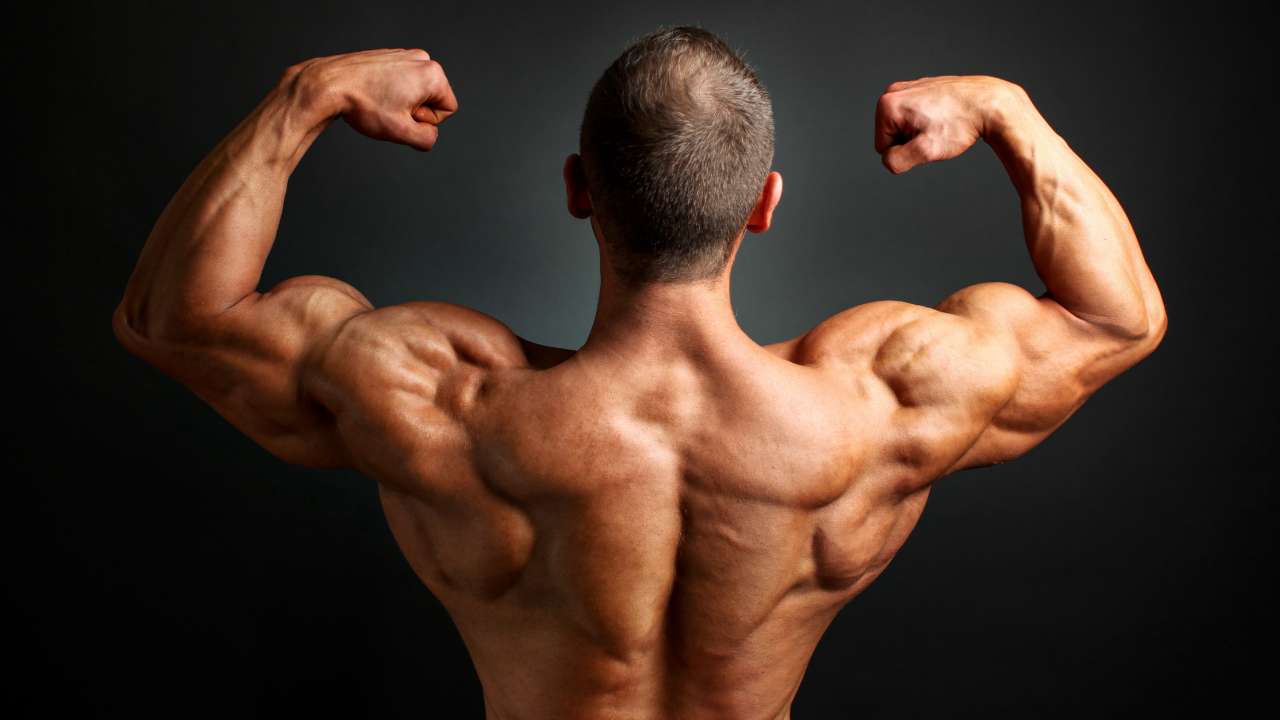
- What Are Wings Workout?
- At Home Bodyweight Wings Exercises
- 1. Pull Up
- 2. Inverted Row
- 3. Resistance Bands Lat Pulldown
- Dumbbell Wings Exercises
- 4. One-Arm Dumbbell Row
- 5. Renegade Row
- 6. Dumbbell Deadlift
- Barbell and Gym Machine Wings Exercises
- 7. Bent Over Barbell Row
- 8. Landmine Row
- 9. Lat Pulldown
- 10. Chest Supported Row
- Wings Workout Plan for Beginners
- At Home Wings Workout Plan
- References
What Are Wings Workout?
Wings workouts refer to training that specifically targets the upper back muscles – the lats, rhomboids, and surrounding areas.
In a nutshell, wing workouts go beyond aesthetics. They’re about building a strong, resilient upper body that supports your every move.
And the best part? Those sculpted wings add serious flair to your physique.
You can do these workouts at home or in the gym, with resistance bands, dumbbells, and barbells.
Pull-ups, chin-ups, bent rows, dumbbell rows, and deadlifts are some of the best wing exercises.
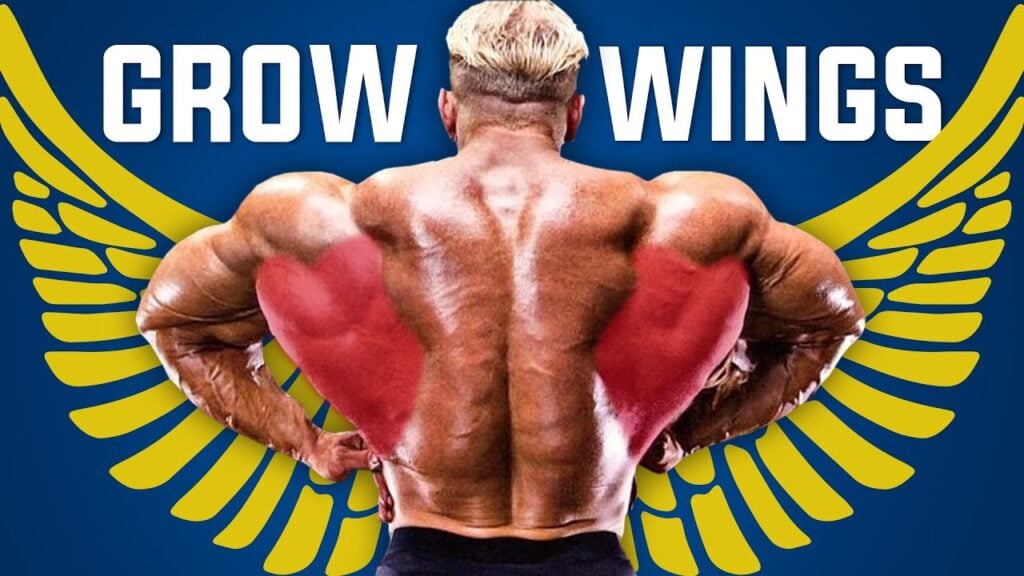
At Home Bodyweight Wings Exercises
You don’t need expensive gym equipment to build wings stronger. There are plenty of bodyweight back exercises you can do at home.
1. Pull Up
Pull-ups are one of the most effective exercises for directly targeting and challenging the lats. The pulling motion recruits the lats to a high degree.
The pull-up increases your back’s strength, thickness, and width, specifically your lats. The lats influence back width and form the “V” in the upper back.
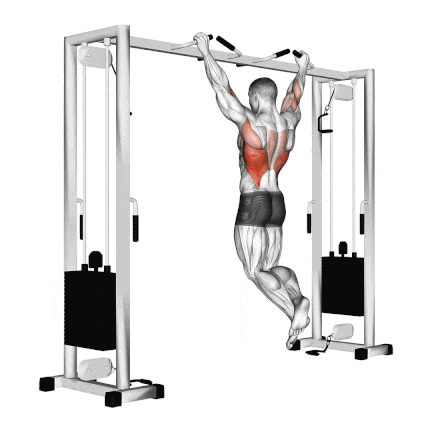
How To Do
- Your hands should be slightly wider than shoulder-width when you grip the bar.
- Pull yourself up until your chin is over the bar. Engage your back and shoulder muscles.
- Focus on pulling your shoulder blades together as you lift yourself up. This will help recruit the larger muscle groups instead of relying solely on arm strength.
- Use controlled motions. Avoid swinging or kipping the pull-up.
- It would be best if you slowly lowered yourself with control.
- Gradually increase the difficulty over time. Incorporate pull-up variations. Try different grip widths, mixed grips, and negative pull-ups (focusing on the lowering phase) to target your muscles from different angles.
2. Inverted Row
The inverted row (bodyweight rows) creates a horizontal body position, making it easier to perform. It works the back and shoulder muscles from a different angle and improves upper body strength.
In the gym, most people utilize the Smith machine for this exercise.
You can also do the inverted row at home by lying under a chair and pulling yourself up.
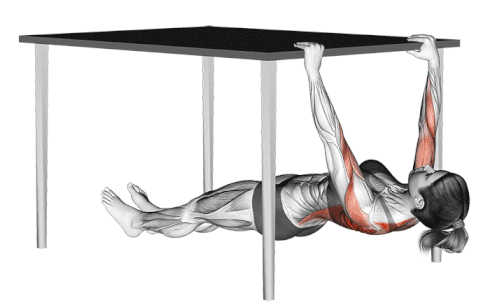
How To Do
- A sturdy table, bench or squat rack should be set up at hip height.
- You can grip the edge of the surface with your hands slightly wider than shoulder-width apart.
- Keep your body straight from heels to head and hang from the surface with your arms extended.
- Start the movement by pulling your shoulder blades together and bending at the elbows to pull your chest up towards the surface.
- When the top of your chest touches the surface, slowly lower yourself back down with control.
- Repeat.
3. Resistance Bands Lat Pulldown
The resistance band lats pulldown can be done anywhere, so it’s a good option for home workouts or while travelling.
It is a compound exercise that engages multiple muscle groups of the back, specifically the latissimus dorsi (lats) and teres major.
There are some variations of the resistance band lat pull-down to add to your back workout:
- Close-grip pulldown
- Wide-grip lat pulldown
- One-arm pulldown
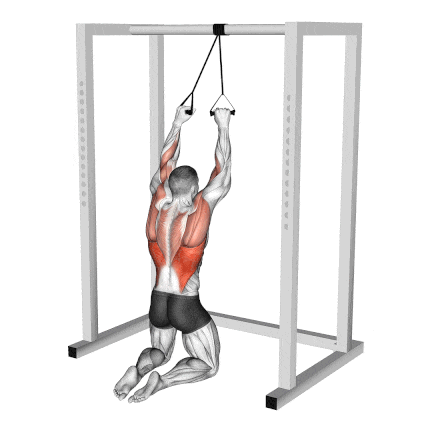
How To Do
- Attach the resistance band to a sturdy anchor point above your head, such as a door frame.
- Kneeling and grasping the resistance band with an overhand grip.
- Step back to create tension in the band. Engage your core and slightly lean back.
- Pull the band down towards your chest. Squeeze your shoulder blades together at the end of the movement.
- Slowly release the tension and return to the starting position.
- Make sure you control the movement both on the way down and up.
- Do 3–4 sets of 10–12 repetitions.
Dumbbell Wings Exercises
Dumbbell wings exercises are all about building that strong, wide back with just a pair of dumbbells.
These moves don’t just sculpt your lats for that eye-catching “wings” look — they also bring balance to your upper body by working each side independently.
4. One-Arm Dumbbell Row
If you’re looking for straightforward dumbbell wing exercises to add to your routine, the One-arm dumbbell row is a great staple exercise to get you started.
It is an excellent full-range exercise to build the lat muscles. This helps to work on each side independently, thereby providing better muscle isolation and a longer range of motion.
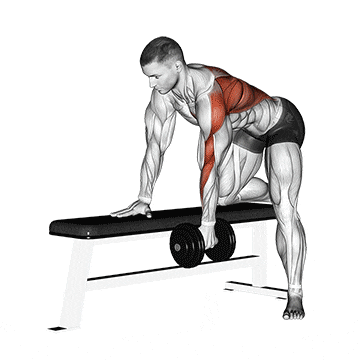
How To Do
- Stand with feet shoulder-width apart.
- Lean forward and place one knee and the same-side hand on the bench.
- Your back should be parallel to the ground, and your other foot should be planted on the ground.
- With the free hand, grab the dumbbell with a neutral grip.
- Engage your lats and pull the dumbbell upward towards your lower ribcage.
- Squeeze your shoulder blade hard at the top of the row. hold that contraction for a second and really feel that muscle working.
- Slowly lower the dumbbell back to the starting position. Repeat on the other side.
- Start light on the weight, especially if this is new to you. It’s more important than how much you can row.
5. Renegade Row
If you’re looking to build up your “wings” (the lats and upper back) and you don’t have access to a gym, the renegade row is an exercise you must have in your arsenal.
The renegade row is a compound, unilateral row variation that challenges your lats, biceps, core, and overall upper body strength in a major way. And like a plank, also train the core.
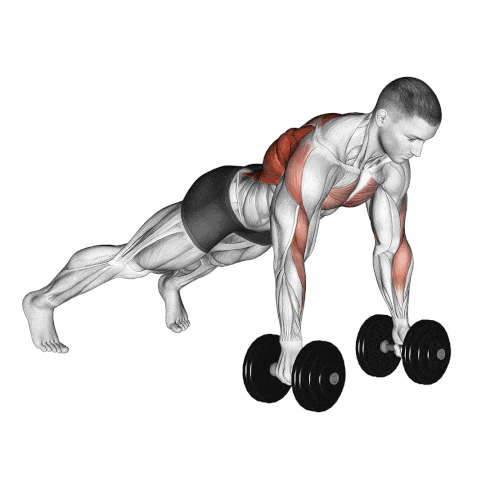
How To Do
- Place two dumbbells on the floor about shoulder-width apart.
- Start in the top position of a push-up position with your hands on the weights.
- Pull your right elbow back and raise the dumbbell toward your chest. Keep your right elbow close to your torso, your abs tight, and your hips in one line.
- Pause at the top of the row and feel that contraction in your lats. Then, inhale as you slowly lower the weight back down with control.
- Repeat the same steps on the other side. Repeat.
6. Dumbbell Deadlift
The deadlift is the King of all exercises, and It is a powerful exercise designed to build an overall physique that uses more muscles than any other exercise.
As a compound lift, the dumbbell deadlift challenges the entire posterior chain – from your grip strength to your he back, erector spine, glutes, and hamstrings. This carryover to greater overall upper body strength.
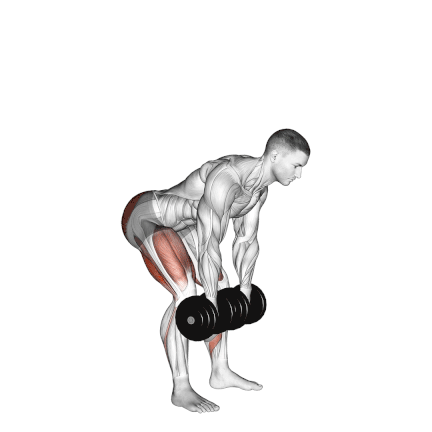
How To Do
- Place a dumbbell in front of you. Grab the dumbbells with each of your hands.
- Raise the dumbbell from the ground using your hamstrings and glutes.
- You should keep your legs slightly bent, your back straight, and your head looking up.
- Raise it to the point where your body is erect.
- Hold the dumbbell for a moment at the top of the lift.
- Now, lower the dumbbell slowly at a steady slow pace by bending at the hips first and then at the knees.
- Pro-tip: The deadlift can cause more harm than good if performed incorrectly. Keep the back straight at all costs.
Barbell and Gym Machine Wings Exercises
7. Bent Over Barbell Row
This compound pulling exercise is a true staple in any serious lifter’s routine, and for good reason. The barbell row recruits the lats like few other movements can, making it a prime wing-building exercise.
The pulling motion of the barbell row directly targets the lats.
The barbell row also heavily recruits the upper back muscles, like the traps and rhomboids. This creates a balanced, thick, and developed upper body.
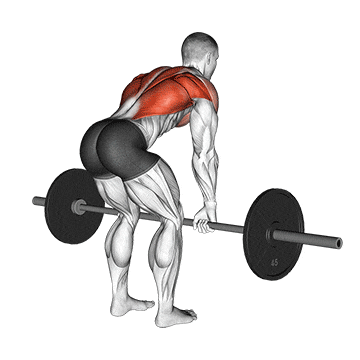
How To Do
- Garb the barbell with your hands slightly wider than shoulder width.
- Engage your core, hinge at the hips, and get your torso parallel to the floor. Keep that back neutral.
- As you initiate the row, focus on driving those elbows back hard. Squeeze those shoulder blades together at the top of the movement to ignite your lats.
- Don’t just use your arms – this is all about that mind-muscle connection with your back.
- Control that weight on the way down, don’t just let it fall. Squeeze those glutes and brace that core to maintain perfect form from start to finish.
- If you really wanna take this exercise to the next level, try mixing in some static holds at the top. Just pause for a second, maintain that squeeze, and feel the burn. That’s how you build that thick, dense muscle.
8. Landmine Row
If you are looking to add freshness and variety to your back workouts and give yourself a new challenge, try this landmine row exercise.
The landmine row allows you to row the weight in a more natural, diagonal path than a traditional barbell row.
Studies indicate that landmine row helps target the lats, rhomboids, and rear delts while letting you use heavier-weight
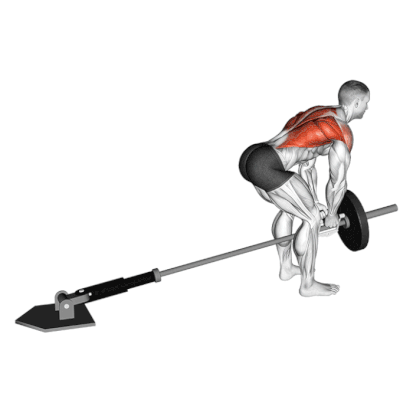
How To Do
- If you are using a classic bar, you must place it in the corner of a wall to block one of its ends.
- To increase range of motion, use small discs, rather than Olympic discs with a large diameter.
- Get into a bent-over position with your spine straight and your chest up.
- Lift the bar until it almost touches your chest with it.
- Focus on contracting your mid-back muscles by sliding your shoulder blades back.
- Now, slowly lower the bar back to the starting position.
9. Lat Pulldown
The Lat Pulldown is one of the most popular and versatile gym machines. It is specifically designed to target the muscles in your back, primarily the latissimus dorsi (or “lats”).
The exercise also engages other muscles including the biceps, trapezius, and shoulders to some extent.
The exercise is easy to learn and very effective at building back strength. The lat pulldown can be performed with different variations.
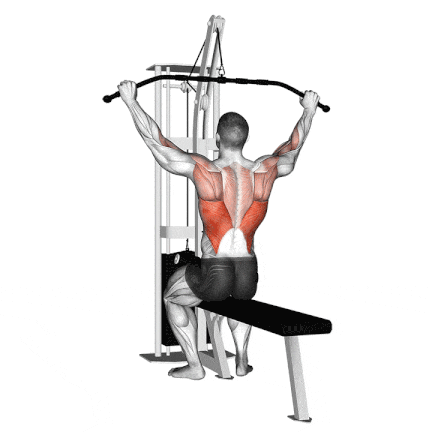
How To Do
- Make sure you sit down on the lat pulldown machine and the thigh pads.
- Reach up and grasp the bar with an overhand grip, with hands wider than shoulder width apart.
- Keep your back straight while sitting up straight and slightly lean back.
- A slight lean is okay, but too much leaning can take the focus away from the lats.
- Pull the bar downwards towards your upper chest. To perform this action, focus on using your lats, not your biceps.
- Slowly return the bar to its starting position.
10. Chest Supported Row
The chest supported machine row is a special piece of gym equipment that helps you work your wings muscles while also supporting your chest and body.
This machine is an excellent option for those who have lower back issues or want to focus exclusively on their upper back muscles, since it minimizes the strain on your lower back.
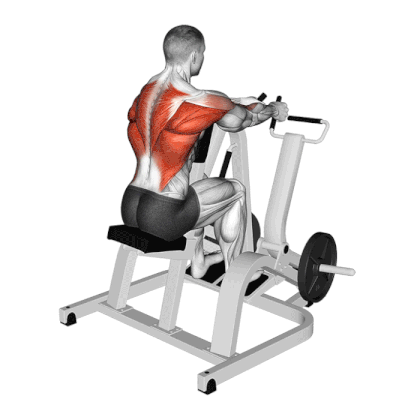
How To Do
- Adjust the seat height so your feet comfortably rest on the platform or footrests.
- Sit up straight with a neutral spine. Your chest should be pressed lightly against the chest pad.
- Start by pulling your elbows back towards you.
- As you pull, focus on squeezing your shoulder blades together.
- Slowly release the handles forward in a controlled manner.
- Allow your back muscles to relax as you return to the initial position.
- Most row machines will offer grip options – wide grip or neutral grip. Please choose based on your preferences.
Wings Workout Plan for Beginners
| Exercise | Sets | Reps |
|---|---|---|
| One-Arm Dumbbell Row | 3 | 8-10 |
| Assisted Pull Up | 3 | 8-10 |
| Lat Pulldown | 4 | 10-20 |
At Home Wings Workout Plan
| Exercise | Sets | Reps |
|---|---|---|
| Pull Ups | 3 | 10-12 |
| Inverted Row | 3 | 8-10 |
| Band Lat pulldown | 4 | 10-12 |
| Dumbbell Pullovers | 4 | 10-12 |
References
- Lehman, G. J., Buchan, D. D., Lundy, A., Myers, N., & Nalborczyk, A. (2004). Variations in muscle activation levels during traditional latissimus dorsi weight training exercises: An experimental study.
- Krzysztofik, M.; Wilk, M.; Wojdała, G.; Gołaś, A. Maximizing Muscle Hypertrophy: A Systematic Review of Advanced Resistance Training Techniques and Methods. Int. J. Environ. Res. Public Health 2019, 16, 4897.
- Paton ME, Brown JM. Functional differentiation within latissimus dorsi. Electromyogr Clin Neurophysiol. 1995;35:301–309

Manish is a NASM-certified fitness and nutrition coach with over 10 years of experience in weight lifting and fat loss fitness coaching. He specializes in gym-based training and has a lot of knowledge about exercise, lifting technique, biomechanics, and more.
Through “Fit Life Regime,” he generously shares the insights he’s gained over a decade in the field. His goal is to equip others with the knowledge to start their own fitness journey.
